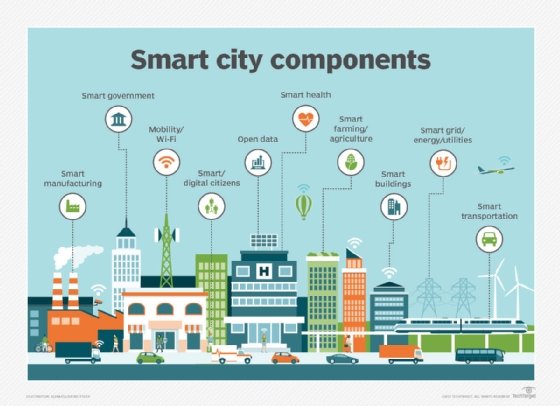
MasterLu - Fotolia
Smart streetlights build smart city network backbone
In order to build a smart city network, you need a strong foundation. One option is to use smart streetlight infrastructure.
Cities across the world are switching out metal-halide and high-pressure sodium streetlights for LEDs not only for the increased security and safety LEDs' brightness brings, but also the energy and cost savings they provide -- an LED bulb uses up to 80% less energy than traditional bulbs.
But there's another reason cities should consider LED adoption: Add connectivity to them, and they light the path toward a larger smart city network.
Upgrading streetlight infrastructure with IoT -- whether owned and run by utilities, energy services or municipalities -- offers additional advantages. For example, lights with dimming features lower when no cars or citizens are in the area. Maintenance crews can also handle issues more efficiently. If a streetlight is on during the day, crews can proactively address it. And if a bulb is out, maintenance crews can be alerted and dispatched before citizens complain.
The advantages of smart streetlights extend beyond the light itself. They create the backbone of a smart city network, providing the power and connectivity additional smart city applications need.
Dan Evans, senior director of product management at Itron Inc., based in Liberty Lake, Wash., calls the smart streetlight the catalyst for the smart city network -- and he's seen it put to work. Evans worked with the city of Chicago, which is set to add traffic monitoring and management capabilities to the 270,000 smart streetlights it will have installed by the end of 2020.
The city of Copenhagen, where cyclist safety is a top priority, has also enlisted Itron's help to deploy traffic management capabilities with its smart streetlight infrastructure. The city of Paris, Evans said, is looking to deploy sensors with its smart streetlights to monitor moisture levels in soil for water conservation.
Smart city applications are numerous and beneficial. With a smart streetlight base, a city's smart city network can truly change the lives of its citizens.
How do you make streetlights smart?
 Dan Evans
Dan Evans
Dan Evans: There are four components. There's the fixture, sometimes referred as the luminaire. Then, there's the control -- what we call a network lighting controller, or NLC. There's also the network. And, finally, there's the software for command and control and data collection.
The entire light fixture is replaced; we're not just changing out a lightbulb. That's because LEDs have a slightly different component tree. Retrofitting the fixtures out there today is time-consuming and costly. It's much quicker to use a fully built-out fixture.
The new fixture with the NLC can now monitor usage, such as power consumption and voltage, as well as identify failure or alarm conditions and communicate them across the network.
How easy is it then to build smart city applications off of that foundation?
Evans: With multiple streetlights deployed with NLCs, you've created what we call a canopy network, which, as the name suggests, is an umbrella of coverage over your entire city or territory where the lights are. Now, any smart city application can be integrated with that network.
There are two types of sensors deployed here: those that need power all the time and those that are battery-based.
Those that need power all the time tap into the power of the streetlights. For example, sensors on a smart streetlight can monitor and manage traffic. A sensor watching traffic on the road using radar or video cameras to determine counts of cars can aggregate that data and send it over the network established by the streetlights. This model can be repeated with other applications.

Battery-based sensors are typically smaller footprint and need to be deployed in areas that don't have power -- think of a water sensor to monitor the level of water in a rain gulley [or] a sewer line; you're not typically going to have power in those areas. And it wouldn't work to have a cellular connection going to that battery-based device, because one of the most important metrics of that battery-based sensor is how the battery lasts.
We've seen cities looking for solutions that will last 10 to 15 years; battery conservation is key. Once the battery-based sensors send data on some radio frequency to the smart streetlight network, the data flows to the back office for analysis.
Whether it's a traffic sensor or a water-level sensor, it's going to need to be displayed. The information has to be conveyed in the software to the appropriate audience that needs to take action.
Who uses smart city data, and how?
Evans: You've got a couple of audiences. One is the city or utility itself -- the crews responsible for maintaining the lighting infrastructure. That's the primary audience for data around alerts and failures. Similarly, traffic departments look at this data to make decisions around road closures or road expansions.
Another audience we've seen popping up is analysts and consultants that offer software that can ingest this data. Their algorithms then help customers make decisions, as opposed to having cities inundated with data sets.
Then, there's the concept of open data. A customer in the U.K., for example, was very much engaged with the city and the local university. Any data that was coming in off the network was put into an open data platform to enable innovation in the city -- making the data available to developers, for example, to take and maybe build that next traffic management software or app, looking at it in a different way than others have traditionally looked at it.
A common problem is each city department only looks at its needs and its solutions. Each city then ends up with multiple networks and applications sometimes doing the same thing. This comes with more overhead from an IT perspective in additional costs for maintenance and management. Cities and their departments can be smarter by deploying one network infrastructure. When you have all these disparate data sets and you're not bringing them together, there's missed opportunity for additional savings.
Key to this is a common data platform, where you've got the opportunity to cross-reference the data sets. You could combine traffic data, lighting data and noise to say, 'OK, what can we determine from this data set? Do we need to take action as a result and change the traffic signal's sequencing or timing?'
What other sort of applications are being built off smart streetlight infrastructure?
Evans: There are four domains of smart city applications: traffic management, sustainable infrastructure, safety and security, and digital services.
Traffic management involves smart parking and smart intersections, where you're providing communications to traffic signals to enable the traffic to move faster through the city, and you're using traffic monitoring and volume of traffic data to make those decisions in real time. The idea is, if you can signal it just right and you move the traffic through city blocks, then you're going to ease congestion.
The second category of sustainable infrastructure, which includes streetlights, allows for reduced energy and a lower carbon footprint. From a safety perspective, it improves the quality of life for citizens. Other examples of sustainable infrastructure would be air quality sensing -- knowing where you have pollution or higher levels of pollution.
Then, there are water levels; determining where you might have a high water level helps identify areas of potential flooding. Likewise, sensors for sewer levels -- no one likes to think of when sewers overflow and cause potentially significant safety problems -- can send proactive alerts and warnings to dispatch crews to address infrastructure issues before they occur.
Another example is smart waste management. With sensors on waste bins, you can dispatch sanitation crews to empty them only when they are full. This helps companies save money on operations. Smart waste management also ties back to traffic management -- you're getting trucks off the road, as they don't need to go empty a container that's only a little bit full.
The third category is safety and security. This could include acoustic sensors for gunshot detection, for example. Sensors will pick up the sound and identify if it's just a car backfiring or if it's actually a gunshot. Then, using triangulation techniques, the location of the shooter can be determined and sent to public safety authorities.
Another example is gas leak detection. We've deployed methane gas detectors with Con Edison in New York City that will identify potential gas leaks before a problem occurs. Radiation detection is another example.
The last category is digital services -- things like digital signage and kiosks. With digital advertisements, there's a return of revenue to the city, but cities can also display public service announcements, like Amber or Silver Alerts for missing children and missing persons. Kiosks can also be used for wayfinding. A visitor to the city can use the kiosk to get information about nearby businesses or points of interest.
Digital services also include things like public Wi-Fi.
What is the penetration of smart city applications, such as smart streetlights, today?
Evans: The penetration of LED infrastructure in the U.S. right now is somewhere in the 10% to 15% range. And, of that, there's probably only about 3% to 4% where they've enabled controls.
Reports show the market for LED upgrades between now and 2027 are getting to the 90% to 95% saturation level. So, the market is moving in that direction, and we see a similar timeline to enable smart city solutions.
The economics of going back to every streetlight pole to add the networking or controls fall apart if you have to go back to every light. If cities are going to change to LEDs, take that opportunity to also add controls.








